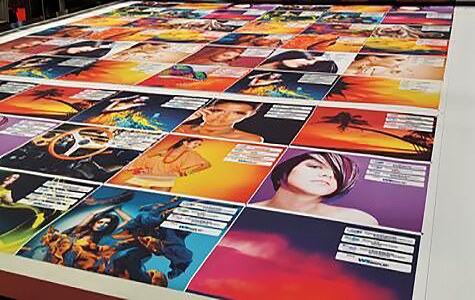With the advantages of today’s digital technology, it is faster and easier than ever to produce a textile sign. The following touches on what you need to know about fabric options and benefits, to help you determine your needs and the solutions that will work for your shop.
Common Fabrics and Use
Polyester is king as far as fabric signage. Polyester comes in various weights, opacity, stretch and styles. It can be produced with stretch, blackout opacity, see-through, etc. Natural fabrics are not very common, but as pigments and fabric coating improve, I suspect this will change.
The two types of construction most commonly used are woven and warp knits. Woven will provide a more opaque fabric, which is ideal for backlit display. The disadvantages with woven are that it can fray and needs to be sewn or sealed by heat. Woven also tends to not be very stretchy. Warp knits — more commonly used — tend to be manufactured with stretch in various degrees to meet the needs of the hardware structure. They are also easier to finish and display.
Why Use Fabric?
Fabric will appear richer, look higher-end and won’t show seams for larger displays or produce glare from external lighting. The best part is fabric is much cheaper! I realize a vinyl shop may argue that vinyl material costs are cheaper than fabric, but let’s compare the two options. To ship a paper or vinyl display, it must be rolled and placed in a tube, for which UPS and Fedex just raised their rates. Fabric can be folded and shipped in a small box. Fabric displays can typically be installed quickly by one person without tools. Imagine the cost savings at a trade show — you wouldn’t have to pay the high labor cost of union workers. For an in-store display, a single store clerk can change out the fabric display with little or no training. Fabric can be washed and reused. Fabric displays can be created in any shape and size — it’s up to your imagination. Hanging fabric displays are also lighter and safer if they fall.
But the best advantage? Fabric is the greenest solution. The inks are water-based (dye sub and dispersed), so there are no nasty volatile organic compounds, and the polyester can be recycled or even manufactured from recycled yarn. In some areas, government regulation will require the use of fabric. Visit Europe or western Canada and try to find any material that is not fabric hanging on public structures. That’s why I pose the question, “Why not fabric?”
Fabric is here to stay and grow. If you are not offering fabric to your customers, a competitor will. If you do not want to make the investment until you have fabric customers, you can still offer it by outsourcing to a number of great companies that specialize in wholesale printing. There is no reason to wait — start offering digitally printed textiles today!
Want to learn more about digital textile printing? Save the date for Digital Textile Printing Conference 4.0 (December 11 - 12; Durham, North Carolina).